10 Most Popular Cheeses Originated in Greece

Greece is renowned for its rich cultural heritage, stunning landscapes, and delicious cuisine. One of the highlights of Greek cuisine is undoubtedly its wide range of cheeses, each with a unique flavor and history. From tangy feta to creamy kefalotyri, Greece has produced some of the most popular and beloved cheeses in the world.
In this article, we will explore the 10 most popular cheeses originated in Greece, their distinct characteristics, and how they are used in traditional Greek dishes. Grab a glass of wine and get ready to discover some of Greece’s most delicious culinary treasures!
The 10 Most Popular Greek Cheeses (BEST)
| Cheese Name | Short Description | Tasting Profile |
|---|---|---|
| Feta | A brined curd cheese made from sheep’s and goat’s milk. | Salty, tangy flavor with a crumbly yet creamy texture. |
| Graviera | A wheel-shaped cheese made from a blend of cow, goat, and sheep milk. | Sweet, nutty flavor with a slightly grainy texture. |
| Kasseri | A medium-hard pale yellow cheese, made from unpasteurized sheep’s milk and a small amount of goat’s milk. | Mild, buttery flavor with a semi-hard texture. |
| Myzithra | A traditional cheese produced from the whey of sheep’s or goat’s milk cheeses. | Mild, slightly sweet flavor with a soft, creamy texture. |
| Kefalotyri | A hard, salty yellow cheese made from sheep milk or goat’s milk. | Sharp, salty flavor with a hard, grating texture. |
| Kefalograviera | Made of sheep’s milk or a mixture of sheep and goat’s milk. | Salty, robust flavor with a firm texture. |
| Anthotyro | A traditional fresh cheese made from sheep’s or goat’s milk, or a mixture of both. | Mild, slightly sweet flavor with a soft, creamy texture. |
| Katiki Domokou | A spreadable, creamy cheese made from goat’s and/or sheep’s milk. | Slightly sour flavor with a smooth, creamy texture. |
| Xynomyzithra Kritis | A soft, creamy cheese with a slightly sour taste, made from goat’s or sheep’s milk and whey. | Slightly sour, milky flavor with a soft, creamy texture. |
| Kopanisti Mykonou | A soft, peppery cheese known for its strong smell due to the fermentation process. | Spicy, tangy flavor with a creamy, crumbly texture. |
1. Feta

- Milk Type: Sheep’s and Goat’s Milk
- Taste: Salty, Tangy
- Texture: Crumbly yet Creamy
- Food Pairing: Greek Salads, Spanakopita (Spinach Pie), Watermelon
- Wine Pairing: Dry White Wines, Rosé
- Read in-depth guide
Feta is a quintessential Greek cheese known for its distinctive salty and tangy flavor profile. It’s traditionally made using sheep’s milk, or a blend of sheep’s and goat’s milk. The cheese is white in color, with a crumbly yet creamy texture, which is a result of the unique brining process it undergoes.
Feta is incredibly versatile and adds a burst of flavor to a variety of dishes, including the classic Greek salad. It’s also used in pastries and often served with olive oil and herbs as a simple yet delicious appetizer.
2. Graviera
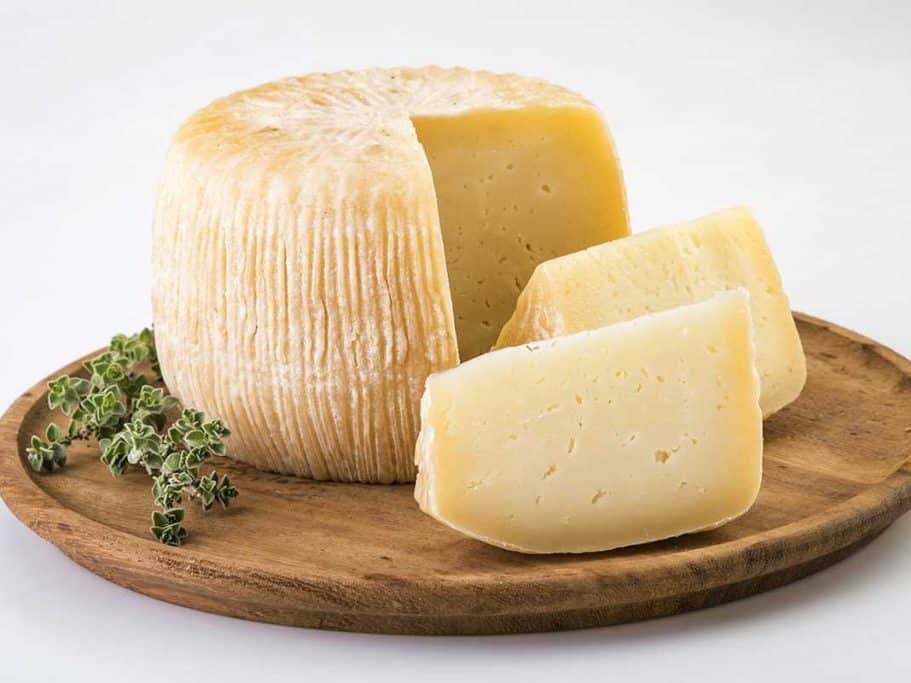
- Milk Type: Blend of Cow’s, Goat’s, and Sheep’s Milk
- Taste: Sweet, Nutty
- Texture: Slightly Grainy
- Food Pairing: Grilled or Fried as Saganaki, Sliced in Sandwiches
- Wine Pairing: Full-bodied White Wines, Light Red Wines
- Read in-depth guide
Graviera is one of the most popular cheeses in Greece, known for its sweet and nutty flavor. It’s primarily made from a blend of cow’s, goat’s, and sheep’s milk, giving it a unique depth of taste. The cheese has a slightly grainy texture and a pale yellow hue. Graviera can be enjoyed in various ways – it can be sliced and eaten directly, grilled or fried as saganaki, or used in sandwiches. With its hearty flavor and versatile nature, Graviera holds a special place in Greek cuisine.
3. Kasseri
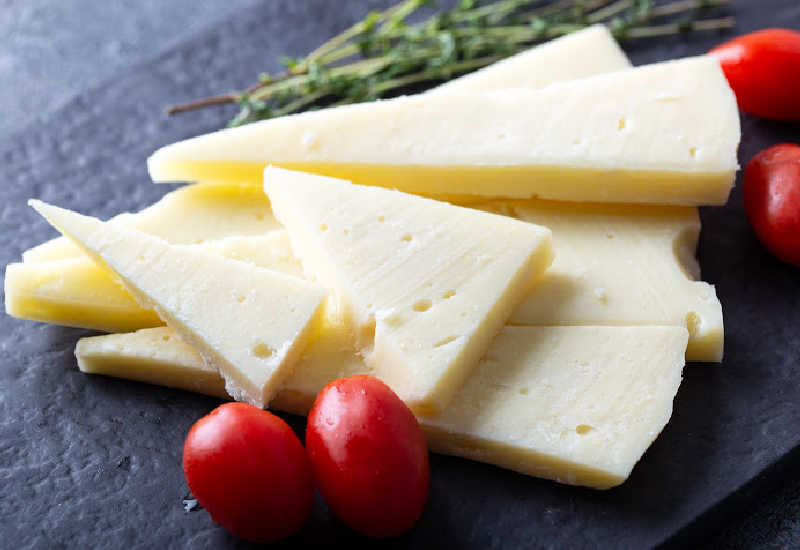
- Milk Type: Sheep’s Milk and a small amount of Goat’s Milk
- Taste: Mild, Buttery
- Texture: Semi-hard
- Food Pairing: Greek Pizzas (Pita), Sandwiches, Saganaki
- Wine Pairing: Chardonnay, Sauvignon Blanc
- Read in-depth guide
Kasseri is a traditional Greek cheese with a semi-hard texture and a unique, slightly tangy flavor. It’s made primarily from sheep’s milk, often combined with a small amount of goat’s milk. Kasseri is notable for its smooth, elastic consistency and pale yellow color. When melted, it becomes enticingly creamy, making it a popular choice for dishes like pizza and grilled cheese sandwiches. Enjoyed both on its own or as part of a meal, Kasseri offers a taste of Greek culinary tradition with every bite.
4. Myzithra
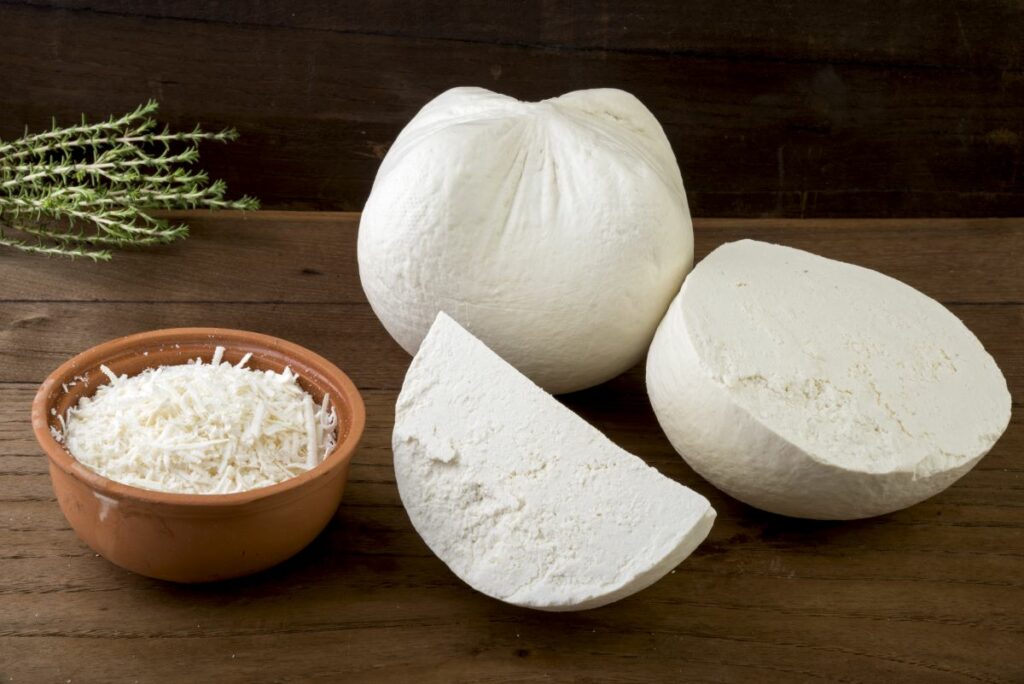
- Milk Type: Whey from Sheep’s or Goat’s Milk Cheeses
- Taste: Mild, Slightly Sweet
- Texture: Soft, Creamy
- Food Pairing: Desserts, Pastries, Pasta Dishes
- Wine Pairing: Sweet Wines, Dessert Wines
Myzithra is a traditional Greek cheese that comes in two distinct forms: fresh and aged. The fresh version, often called sweet Myzithra, is soft and creamy, similar to ricotta, while the aged version is hard and salty, perfect for grating over pasta.
Made from sheep’s or goat’s milk whey, Myzithra has a slightly tangy flavor. Whether spread on bread, sprinkled over dishes, or enjoyed as a dessert with honey, this versatile cheese is a staple in Greek cuisine.
5. Kefalotyri
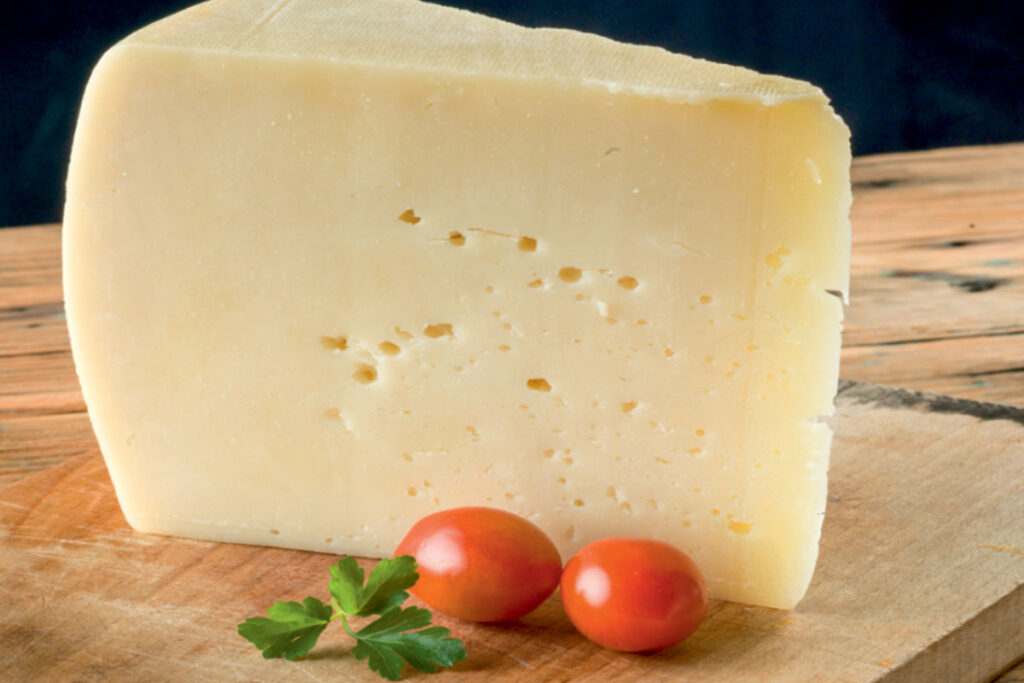
- Milk Type: Sheep’s Milk or Goat’s Milk
- Taste: Sharp, Salty
- Texture: Hard, Ideal for Grating
- Food Pairing: Pasta Dishes, Grated Over Salads, Saganaki
- Wine Pairing: Robust Red Wines, Aged White Wines
- Read in-depth guide
Kefalotyri is a well-respected cheese in the Greek culinary tradition, known for its hard texture and strong, salty flavor. Made predominantly from sheep’s or goat’s milk, Kefalotyri is often aged for several months, enhancing its bold taste.
Its firmness makes it an excellent grating cheese, perfect for topping pasta dishes, while its robust flavor shines when it’s served as a table cheese. From saganaki to moussaka, Kefalotyri plays a starring role in many Greek dishes.
6. Kefalograviera
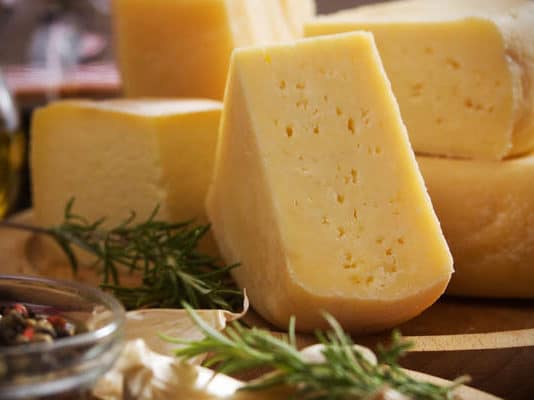
- Milk Type: Sheep’s Milk or a mixture of Sheep and Goat’s Milk
- Taste: Salty, Robust
- Texture: Firm
- Food Pairing: Grilled as Saganaki, Pasta Dishes
- Wine Pairing: Full-bodied Red Wines, Aged White Wines
- Read in-depth guide
Kefalograviera is a Greek cheese known for its slightly sweet and nutty flavor. It’s a hard cheese, primarily made from sheep’s milk or a mixture of sheep’s and goat’s milk. With a pale yellow color and small holes scattered throughout, Kefalograviera has a texture that strikes a balance between firm and elastic. It’s particularly beloved for its frying and grilling qualities, making it the star of the famous Greek dish, saganaki. Whether enjoyed as a snack, in a sandwich, or in cooked dishes, Kefalograviera adds a touch of Greek flavor.
7. Anthotyro

- Milk Type: Sheep’s or Goat’s Milk, or a mixture of both
- Taste: Mild, Slightly Sweet
- Texture: Soft, Creamy
- Food Pairing: Desserts, Greek Pies, Spread on Bread
- Wine Pairing: Light White Wines, Rosé
Anthotyro is a traditional Greek cheese that’s loved for its mild and slightly sweet flavor. This cheese is made predominantly from sheep’s or goat’s milk whey, with the addition of fresh milk which contributes to its creamy texture. Anthotyro comes in two forms: fresh and hard.
The fresh version is soft and moist, often used as a spread or in desserts. The hard version, which is aged, has a firmer texture and is ideal for grating over dishes. Whether enjoyed on its own, in salads, or in baking, Anthotyro offers a delightful touch to Greek cuisine.
8. Katiki Domokou

- Milk Type: Goat’s and/or Sheep’s Milk
- Taste: Slightly Sour
- Texture: Smooth, Creamy
- Food Pairing: Spread on Bread, Greek Salads
- Wine Pairing: Dry White Wines, Sparkling Wines
Katiki Domokou is a Greek cheese known for its smooth, creamy texture and tangy flavor. Originating from the Domokos region, this cheese is made primarily from goat’s or sheep’s milk.
Unlike many other Greek cheeses, Katiki Domokou is a spreadable cheese, making it a popular choice for sandwiches, dips, or simply spread on bread. It’s often enjoyed with a drizzle of honey or some olives, offering a delightful blend of flavors that captures the essence of Greek gastronomy.
9. Xynomyzithra Kritis
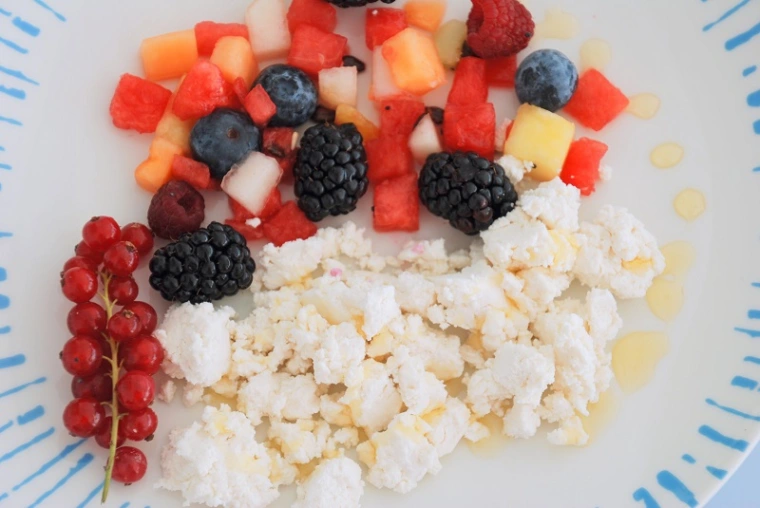
- Milk Type: Goat’s or Sheep’s Milk and Whey
- Taste: Slightly Sour, Milky
- Texture: Soft, Creamy
- Food Pairing: Greek Pies, Desserts
- Wine Pairing: Light Red Wines, Sweet White Wines
Xynomyzithra Kritis is a delicious and tangy Greek cheese that is made using traditional methods. It is a soft and creamy cheese that is made from whey, which is blended with either sheep or goat milk. The resulting cheese has a sour taste and a granular texture, making it versatile and perfect for use in a wide range of dishes.
It is highly regarded in Greece, where it is produced mainly on the island of Crete, and enjoys a protected designation of origin status. Whether you enjoy it as a table cheese or use it in your favorite recipes, Xynomyzithra Kritis is sure to delight your taste buds with its unique flavor and texture.
10. Kopanisti Mykonou
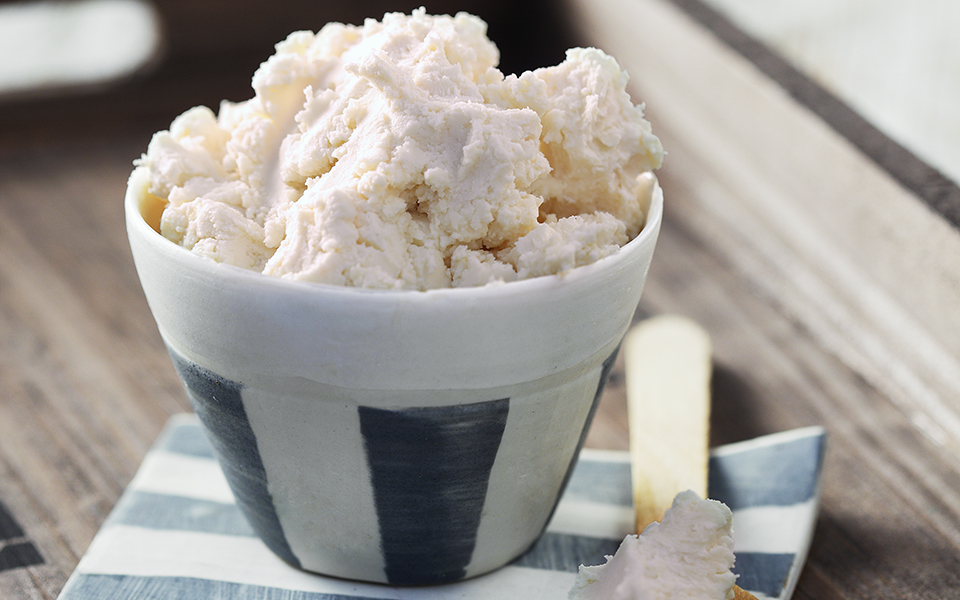
- Milk Type: Cow’s, Sheep’s, or Goat’s Milk
- Taste: Spicy, Tangy
- Texture: Creamy, Crumbly
- Food Pairing: Greek Meze Platter, Spread on Bread
- Wine Pairing: Full-bodied Red Wines, Robust White Wines
Kopanisti Mykonou is a flavorful, spicy Greek cheese made from a blend of cow’s and sheep’s milk. With its crumbly texture and bold taste, it’s a versatile cheese that can be enjoyed on its own or used to add a kick to your favorite dishes.
Originating from the island of Mykonos, Kopanisti Mykonou is a must-try for any cheese lover looking for something a little different.
Final Thoughts
These cheeses are a testament to the country’s rich culinary heritage and traditions. Each cheese has its unique flavor profile and texture, making them a versatile and delicious ingredient in many dishes. Whether you enjoy them on their own, as part of a mezze platter or used to elevate your favorite recipes, the cheeses of Greece offer something for every cheese lover.
From the tangy taste of feta to the delicate flavor of manouri, Greece’s cheese-making traditions are a true delight to the senses. So, next time you’re in the market for some cheese, why not try something new and explore the wonderful world of Greek cheeses?
Also read:





